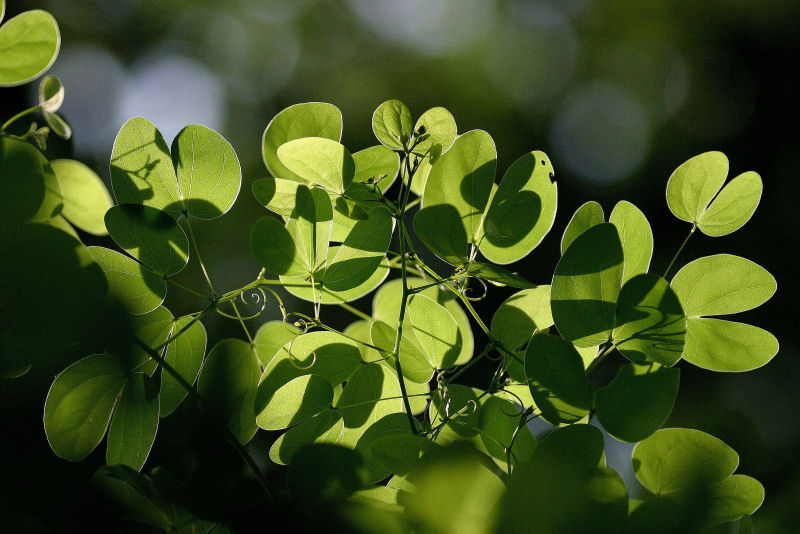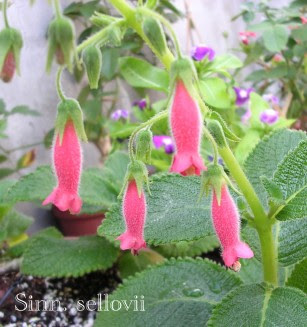
HETEROPTERYS H. B. K., Nov. Gen. Sp. 5 [quarto ed.]: 163. 1822 ["1821"], nom. cons.— Lectotype: H. purpurea (L.) H. B. K., typ. cons.
Banisteria L., Sp. Pl. 427. 1753.—Lectotype, designated by T. A. Sprague, Gard. Chron. ser. 3, 75: 104. 1924: B. brachiata L. [H. brachiata (L.) DC.].
Clonodia Griseb. in Mart., Fl. Bras. 12(1): 26. 1858.—Type: C. verrucosa Griseb. in Mart. [H. racemosa Adr. Juss.].
Atopocarpus Cuatrec., Webbia 13: 454. 1958.—Type: A. papillosus Cuatrec. [H. racemosa Adr. Juss.].
Skoliopterys Cuatrec., Webbia 13: 451. 1958.—Type: S. lehmanniana (Nied.) Cuatrec. [H. complicata (H. B. K.) W. R. Anderson & C. Davis].
Woody vines, shrubs, or small trees; stipules very small, distinct, triangular, persistent, borne on edge of petiole at its base or on stem beside petiole, or absent; leaves opposite or very rarely alternate or whorled, usually bearing glands on petiole or lamina or both. Inflorescence with the flowers borne in umbels, corymbs, or pseudoracemes, these single or grouped in racemes or panicles, axillary or terminal or both; floriferous peduncle usually well developed, absent in some species; bracteoles borne at or below apex of peduncle. Sepals leaving outermost petal exposed in enlarging bud or (in one subgenus) concealing petals until anthesis, eglandular or the lateral 4 biglandular, or perhaps occasionally all 5 biglandular with the glands on anterior sepal connate with adjacent glands; corolla bilaterally symmetrical, the posterior petal ± strongly differentiated from the lateral 4 petals; petals light yellow or pink or pink and white in most species, white, bronze, or dark red in a few species, glabrous in all but a few species; lateral petals with the margin entire, denticulate, or erose; androecium bilaterally symmetrical; stamens 10, all fertile; filaments mostly connate proximally and heteromorphic, generally longer opposite sepals and posterior-lateral petals, the latter 2 often thicker than others; anthers ± alike, the posterior 3 sometimes smaller than others, glabrous in all but a few species, the connective not or hardly exceeding the locules; pollen globally symmetrical, with 4 colpi not perpendicular to the equatorial plane and several pores variously distributed; receptacle glabrous on both sides of stamens; gynoecium bilaterally symmetrical; ovary with the 3 carpels proximally connate and distally distinct, all fertile; styles 3, the anterior style differing at least somewhat from the posterior styles in length and shape; apex of styles with a large, usually internal stigma and dorsally rounded, truncate, acute, or hooked, the stigma very rarely terminal. Fruit dry, breaking apart into 3 samaras or mericarps separating from a short pyramidal torus; samara with its largest wing dorsal, thickened on the abaxial (lower) edge and (in most species) bent upward, the veins terminating in the thinner adaxial edge; much shorter winglets or crests present on the sides of the nut in some species; dorsal wing rudimentary or lost in a few species; carpophore absent. Chromosome number: n = 10.
More than 140 species in diverse habitats, from savannas and dry woodlands to rain forests, in the New World tropics and subtropics from northern Mexico and the West Indies to northern Argentina and southeastern Brazil [map]. One widespread, mostly Caribbean species, H. leona, is also found in low wet places along the coast of West Africa from Senegal to Angola [map].
This is the largest genus in the family, approached in size only by Byrsonima, which is slightly smaller. Like most genera of vines in Malpighiaceae, Heteropterys has each cincinnus reduced to one flower and dry, schizocarpic fruits. The genus is defined by its samaras, which are unique in the family. In most genera whose samaras have a dominant dorsal wing the wing is thickened along the upper (adaxial) margin and the parallel veins bend downward, ending in the thinner abaxial margin. In Heteropterys that situation is reversed—the adaxial margin of the samara is thinner than the abaxial margin, and the wing bends more or less upward, with the veins following that curvature. In spite of the dorsal-winged samara, the overall morphology suggests that this genus is actually more closely related to genera with lateral wings, such as Tetrapterys, than to the large group with the usual type of dorsal-winged samara (Stigmaphyllon, Banisteriopsis, et al.). The molecular information currently available (Davis & Anderson, unpublished data) indicates that Heteropterys is monophyletic.
Samaras superficially similar to those in Heteropterys are found in the genus Ectopopterys. Otherwise, no other member of the family can be confused in fruit with Heteropterys. In flower it is not so distinctive, and there is great diversity among the species in petal color, so correctly placing a member of Heteropterys in this genus without fruits is difficult. As has happened in most large genera with winged fruits, several clades within Heteropterys have independently lost the large dorsal wing; this is especially likely to happen in species that grow near water and have the option of dispersal by water instead of wind. One of those clades is represented by Clonodia, which has mericarps without a dorsal wing and verrucose outgrowths on the nut. Anderson (1981b) suggested that pink-flowered species of Heteropterys were possibly the closest relatives of Clonodia, and molecular evidence (Davis & Anderson, unpublished data) supports that placement, for which reason we have placed Clonodia in synonymy under Heteropterys (Anderson & Davis, 2007; [pdf]).
Heteropterys leona is an especially interesting species, represented by populations along the Atlantic coasts from Belize to Brazil and from Senegal to Angola (C. Anderson, 2001; [pdf]). There is only one other species with that distribution, Stigmaphyllon bannisterioides (C. Anderson, 1997a). The fact that the African populations have differentiated little from their American relatives suggests that those two species managed to migrate from the New World to the Old relatively recently, much later than the ancestors of the other genera of Malpighiaceae found in the Old World.
Linnaeus (1753; pdf) used the name Banisteria for several species with winged fruits. In subsequent decades, as taxonomists defined the genera of Malpighiaceae more narrowly, Banisteria came to be used by several influential specialists, most notably Adrien de Jussieu (1843) and Franz Niedenzu (1928), for the large genus now known as Banisteriopsis. Unfortunately, none of Linnaeus's species is assignable to Banisteriopsis, so it is not feasible to use the name Banisteria in Jussieu's sense. Sprague's designation of Banisteria brachiata [= Heteropterys brachiata] as the lectotype of Banisteria in 1924 fixed the application of that name to the large genus that had become known as Heteropterys. There followed a period of confusion, during which some botanists used the name Banisteria for the traditional Heteropterys, while others continued to use Heteropterys. That situation has now been resolved by the conservation of the name Heteropterys against Banisteria. The spelling Heteropterys has also been conserved against the original spelling, which was Heteropteris.
Reference: There is no modern revision of the genus. Niedenzu's treatment (1928) serves as a starting point, and various tropical floras treat relatively small portions of the genus.
Etymology: The name Heteropterys comes from the Greek words for different (heteros) and wing (pteron), and refers to the fact that the wing of the samara in this genus is radically different from that found in other genera with dorsal-winged samaras.
Uses: A few species are cultivated for their large showy inflorescences and the red immature samaras. The immature fruits of H. glabra are sold in markets in Paraguay under the name "Flor de Tilo"; an infusion made by boiling the fruits in water is said to have curative power.
Photos: view all: H. andersonii, H. atabapensis, H. aureosericea, H.ayachuchensis, H. brachiata, H. cotinifolia, H. glabra, H. hammelii, H. laurifolia, H. leona, H. nervosa, H. orinocensis, H. palmeri, H. purpurea, H. steyermarkii, H. syringifolia
Drawings: view all; (those most representative of the genus in boldface): H. actinoctenia, H. alata, H. aequatorialis, H. aliciae, H. alternifolia, H. atabapensis, H. brachiata, H. complicata, H. caducibracteata, H. conformis, H. cuatrecasasii, H. dichromocalyx, H. fruticosa, H. hatschbachii, H. krapovickasii, H. laurifolia, H. maguirei, H. marleneae, H. mathewsana, H. megaptera, H. murcapiresii, H. neblinensis, H.oblongifolia, H. obovata, H. oligantha, H. oxenderi, H. perplexa, H. prancei, H. purpurea, H. sanctorum, H. sincorensis, H. steyermarkii, H. subhelicina
![]()

////////////////////////////////////////










